#yin et yang
Explore tagged Tumblr posts
Text
So apparently Brian Cocks
ahem Brian Cox
was saying usually large gas giants fall inward and end up closest to the star, very odd of our solar system to not have that; and that would have erased Earth and basically meant Jupiter would exist where the orbits of the inner planets are and the inner planets would be simply dust within a slightly larger Jupiter- in most solar systems this is what happens, according to Cox
but it's the pull of Saturn, the unlikely other gas giant, that pulls Jupiter back into the outer solar system early on- saving Earth's chance for later existence as a warm rocky planet.
Jupiter also deserves credit for acting as a giant gravity shield against asteroids and other stuff that might be hazardous, often times Jupiter just eats it like candy so the dangerous flying "candy" won't hit us and vaporize our continents...so big thanks Jupiter for like, vacuuming up that wild ass drunk comet in 1994
Is this a narrative that parallels the Babylonian creation myth of Enki and Enlil?
The two Gods who created our world, as best friends?...keeping each other in check so they don't go too crazy?
Sounds so familiar to how, while Jupiter protects our world, Saturn reined in Jupiter and stopped Jupiter from destroying us himself too.
Highly plausible that ETs were advanced and spacefaring before our solarsystem was born; we are in a region of space that has factors of a thousand more gold than surrounding regions of our galaxy. There's no natural way to explain this. It's exceedingly, basically airtight likelihood we are living in a solar system that *was* terraformed from the beginning to basically mine gold. That's why we're here, gold is apparently a necessary ingredient in space/time travel equipment, so aside from being pretty, gold is also just very useful, moreso than other elements. Not implausible to consider "sci fi" hypotheses about ET societies tweaking and tinkering with proto-stellar discs, making it more likely rocky inner warm planets will form; thus making it cheaper and easier to later mine gold; that kind of thing actually makes total sense to me.
Sci fi concepts to explore include space elevators, asteroid mining, the perils, the piracy (human and/or ET), the legal challenges after arrival back home with golden asteroids.
Wild to consider taking a $50 trillion gold brick 99% of the way back to earth's orbit only to get held up and mugged at laserpoint by a squad of UFOs
#astromythology#terraforming solarsystems even#planets too#gold mining operation origin story#gold is not just pretty it's a necessary ingredient for high grade ET technology#sci fi concepts#sci fi candy#sci fi writers#imagination exercise#hypothesis building#creativity of science#art in good science#science in good art#yin and yang balance always#posts for#Randall Carlson#Billy Carson#Graham Hancock#et al#Brian Cox...might have a chuckle with this but something tells me he's too British to agree with most of this#Cox is an ET denier#fine by me- not gonna ruin my day and Cox is still a great astrophysicist#there is great power in setting aside minor disagreements and having boldly epic conversations anyway#the power of being able to learn from someone you don't 100% agree with#but that won't stop me from trolling him a bit in the headline sorry brian haha
1 note
·
View note
Text

Philippe Druillet "Yin et Yang des étoiles" Deux Têtes Illustration Originale (2011) Source
1 note
·
View note
Photo


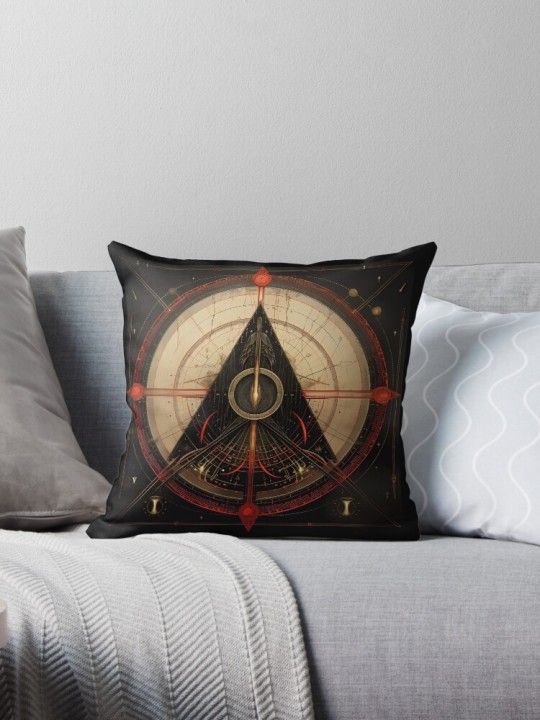



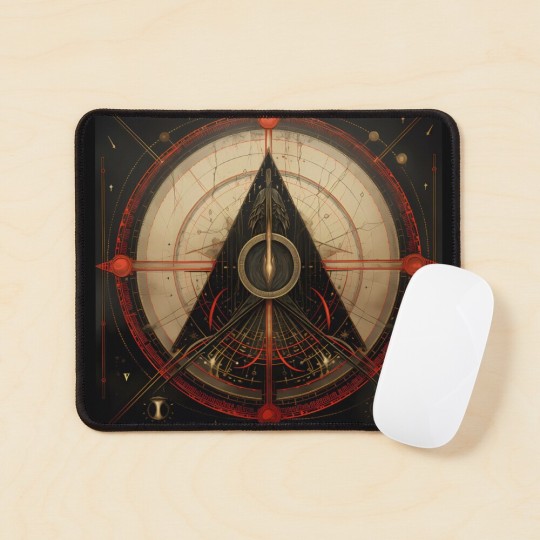

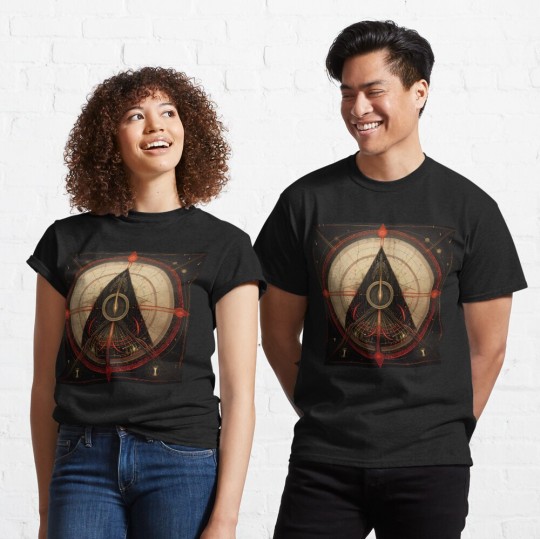

(via Coussin avec l'œuvre « "Duality Symbolized" » de l'artiste Art-Vortex-fr)
#findyourthing#redbubble#Duality Dualité Opposés Yin et Yang Équilibre Forces Contraires Harmonie Deux Mondes Deux Faces Dualisme Symboles Contradiction Double Visio
0 notes
Text
Comme le yin et le yang ☯️ galopant à travers la marée — de couleur opposée, mais en parfaite harmonie.
20 notes
·
View notes
Text
Interpreting the symbolism of the GazettE - Through Darkness to Enlightenment

The DOGMA cover is unconscious imagery. The Priestess in the eye of the storm. The only colors used are the alchemical ones (black, white, gold, red).
In Jungian psychology and alchemy Nigredo or blackness refers to the initial stage of the alchemical process, symbolizing the darkness, chaos, and dissolution that precede transformation and rebirth. It represents a state where the individual confronts their shadow aspects, unconscious fears, and repressed emotions. This stage is characterized by a sense of disintegration and descent into the abyss - depths of the psyche, where the old self must die.
The Nesthead is blackened out to signify that we are entering this 1st stage of the alchemical process. However, she is The Priestess who will come out of this transformative process as signified by her 7 pointed star crown. She (the soul) is surrendering to the darkness, knowing that she is immortal. To quote Ruki in Dogma - "The rite I must face is cloaked in darkness and isolation - Only there will truth be found" . Her right hand is dissolving the repressed trauma and the left has a tight grip on the demons (Solve et Coagula).
Moving on to the next image - it is the The Redefinition Tour cover art from right before the Dogma era. The Goddess of Death. The darkness is Feminine, the creator and destroyer. She oversees the Dark Night of the Soul process as the ruler of the Underworld. She is Yin. She is Izanami in Shinto, although this image is left quite ambiguous and could easily be seen as a death goddess of any other religion.
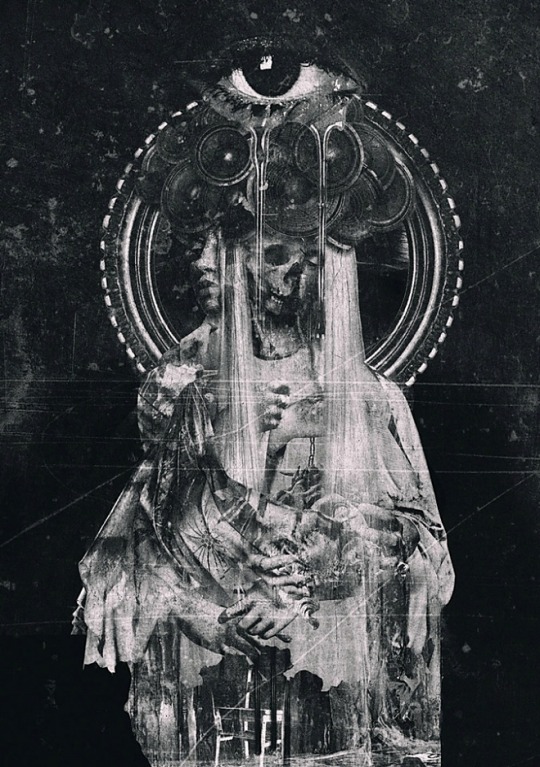
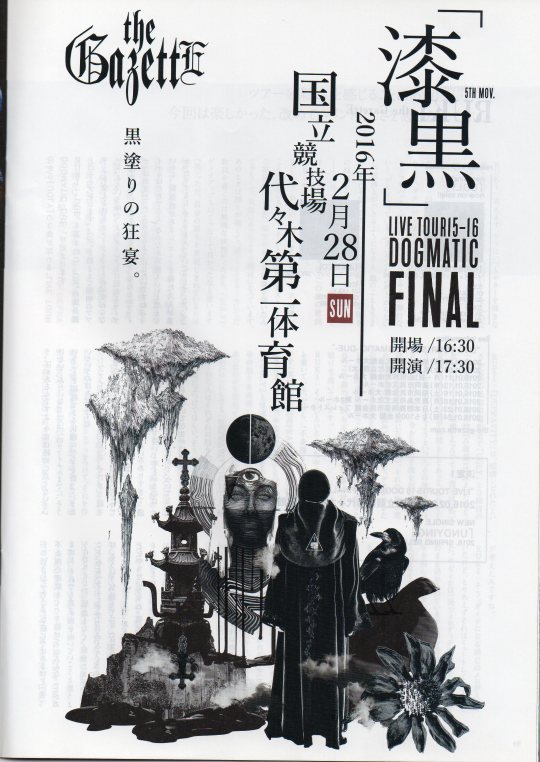
The Dogmatic Final poster. Skulls, crows, rot, decomposition and dying flowers all represent the alchemical Blackness stage. It is depression, isolation, pain, helplessness and despair. Choosing to embrace the Shadow - what is ugly, rotting, dying, unwanted and repressed. These are all common themes in Ruki's lyrics. A faceless priest represents the loss of identity while going through this sacred process. He serves as a mediator between God and the congregation. Ruki wore a priest's Stole throughout the whole Dogma era.
Dogma is the Dark Night of the Soul album. Heaviest sound, richest in symbolism. Ruki is both the priest conducting the purification and the one being purified.
Blemish lyrics: "I want to be reborn. Leave me alone. I had to stifle my cries when I caught sight of my own twisted shadow.[...] In darker dreams.. A goddess speaks to me.. and it seems.. I cannot see the light."
The Japanese word for darkness 闇 "yami," itself carries the meaning of despair, hopelessness, mystery and the unknown. So, it means psychological darkness, much like the Jungian term "shadow." And "yami" is probably Ruki's favorite word to use in lyrics. For example, Ninth Odd Smell:
そう 黒い黒い黒い闇を抱いて Sou kuroi kuroi kuroi yami wo daite (Yes, embracing the black, black, black darkness)
But let's get back to Dogma and analyze each symbol in the Dogma video separately:
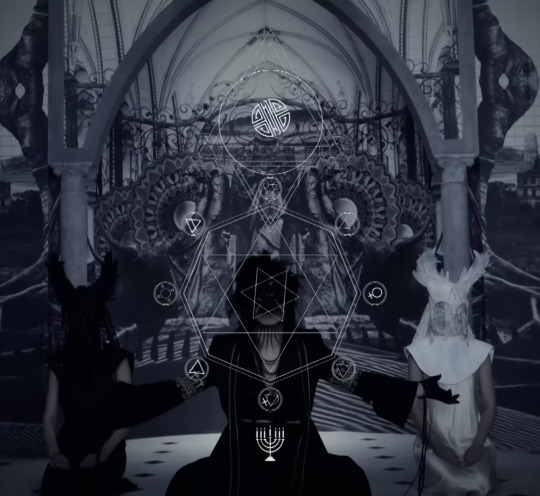
(1) - starting from the bottom the Menorah is a symbol of universal enlightenment. Going up from that, we have alchemical sulfur (evaporation, expansion, and dissolution), then the 4 elemental symbols, then Venus signifying the Anima (Jungian term) on the right. The Hexagrams in the center represent unification of the opposites (Light and Shadow, Yin & Yang). The blacked out face is the dissolution of ego identity.
The image as a whole is reminiscent of the High Priestess in tarot (the Qabalistic path of Gimel, ruled by the Moon, which is the only light in the Dark Night). The black Pillar of Severity and white Pillar of Mercy behind him.

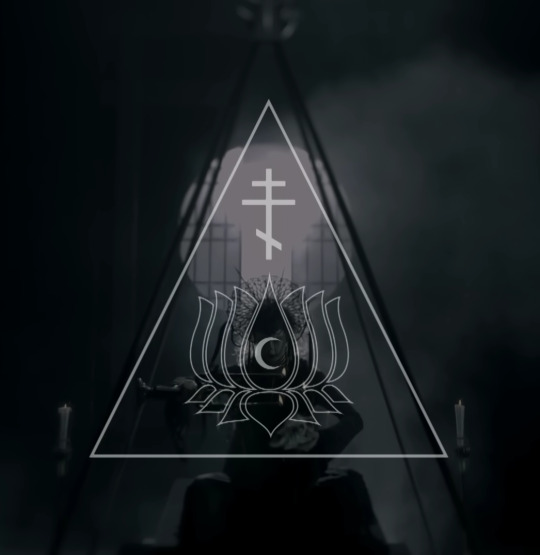
(2) - Light is Consciousness and Shadow is all that is repressed and unwanted. Unification of these opposites is the goal. Upside down triangle is Yin. I'm interpreting this as there can be no enlightenment with Greed. It matches well with the societal critiques Ruki often expresses with his lyrics.
(3) - In Buddhism there's a saying no mud - no lotus. It is a symbol of transmutation. The Moon is Albedo (whiteness)- the insights you gain when embracing and examining your Shadow. And the Orthodox cross at the top is a symbol of salvation and redemption in Christian mysticism. It represents the transformative power of Christ's (Sun) sacrifice and the possibility of spiritual rebirth and renewal for humanity. The vertical bar of the cross is sometimes interpreted as the axis mundi, or cosmic axis, which connects the earthly realm with the divine realm. It is the path of ascent from the material world to the spiritual world.

(4) - Is again the hexagram but with the Leviathan Cross in the center, which is another symbol for sulfur. Interestingly, it is put over the censer - the burning of incense is often associated with purification rituals in mysticism. The fragrant smoke is believed to cleanse the sacred space and purify the participants, preparing them for spiritual practices or encounters with the divine. Sulfur in alchemy represents the soul of all materials and living things. Sulfur is synonymous with consciousness and the expansion of thought. To the ancient alchemist, it’s properties are dryness, heat, masculinity, evaporation, expansion, and dissolution.
(5) - Around the circle we have symbols of different religions - starting with the top it's the Menorah, Hamsa hand, Shinto shrine, Ohm, something with the cross, Celtic and Scandinavian symbols and an 8 pointed star. I would interpret this as saying all the different religions of the world have the same goal that is enlightenment.
Moving on.

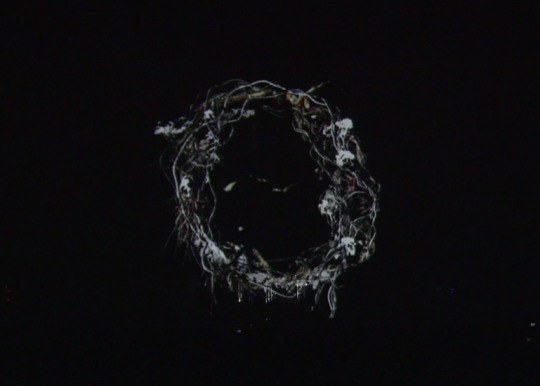
The nest symbolism is interesting. The main character on the Dogma cover is called Nesthead and there is a lot of time spent showing the forming of a nest during Coda live. Coda lyrics: "If I have to forget my true self in order to seize the whiteness, then give me blackness deeper than anything. Beneath this patch of sky, flowers cover the soil where corpses sleep. The beautiful deformity proceeds towards the dazzling darkness, the end and the beginning."
Nests could symbolize the concept of home or refuge, creating a secure place in the living darkness. In Buddhism, the idea of finding refuge in the Three Jewels (Buddha, Dharma, Sangha) is central. Just as a bird seeks safety and shelter in its nest, Buddhists seek refuge in the teachings of the Buddha, the Dharma (the path to awakening), and the Sangha (community). Nests, being temporary structures built by birds for the purpose of nurturing their young, can symbolize impermanence and the transient nature of existence. In Buddhist teachings, impermanence (anicca) is one of the Three Marks of Existence, highlighting the fundamental nature of all conditioned phenomena to arise and pass away. Reflecting on it teaches about the importance of non-attachment, letting go of clinging to things that are ultimately fleeting. Nests are created through the efforts of birds gathering materials and constructing them meticulously. This could symbolize the interconnectedness of all beings and the importance of cooperation and collaboration. In Buddhism, the concept of interdependence (pratityasamutpada) underscores the idea that all phenomena are interconnected and dependent on each other for their existence. Buddhism emphasizes living in harmony with nature and cultivating respect and reverence for all living beings.
I interpret the Nesthead herself as Ruki's Anima (in Jungian psychology Anima is what guides a man through the wilderness of collective unconscious). It's rather obvious Ruki identifies himself with her because of the similarity of poses, clothing and the gorgeous gold armlets they both wear.

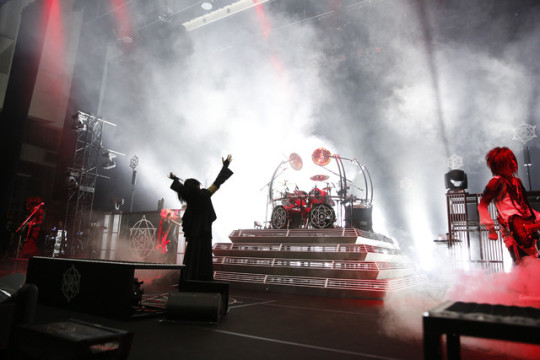
Moving on to the Dogmatic Final Live:
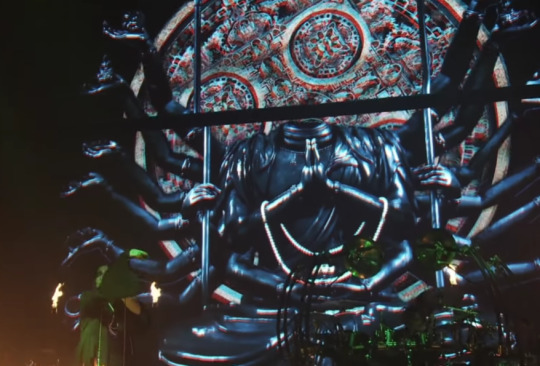
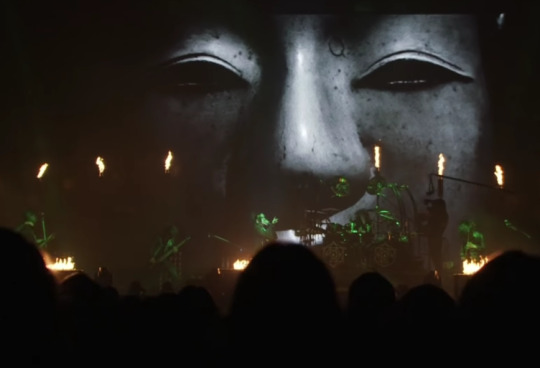
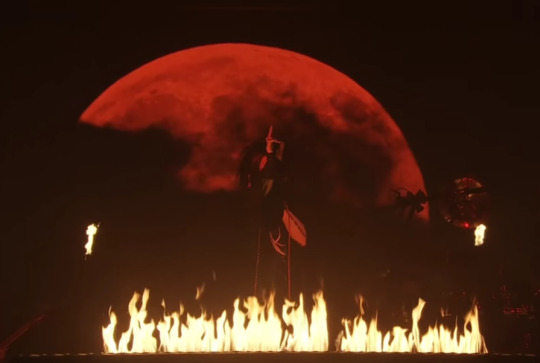

The Wasteland live visuals are very interesting. (Keep in mind it is played after Goddess and they had t-shirt merch saying "Goddess from the Wasteland").
Buddha is depicted headless which reminds me of the goddess Vajrayogini. Her severed head form (Ucheyma) represents the annihilation of the ego (remember the Dogma lyrics "I'll be a brain-dead god"?).
The many hands of the deity suggest it's ability to engage in multiple activities simultaneously for the benefit of sentient beings. This may include granting blessings, bestowing teachings, offering protection, and guiding others along the path. The Trishul (trident) represents the overcoming of the three poisons of ignorance, attachment, and aversion.
Vajrayogini is a personification of the cognitive function of the transformative power within consciousness. Her iconography symbolizes the transmutation of negative emotions and defilements into enlightened qualities, she is wisdom and compassion. She is associated with the transmission of esoteric teachings. Her color is blood red and her fire burns the Shadow. She is often depicted within a hexagram. Something that the GazettE also used during Sludgy Cult live:
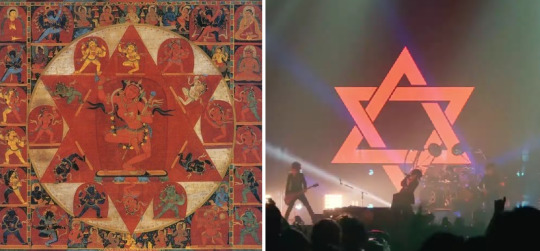
Moving on to NINTH:
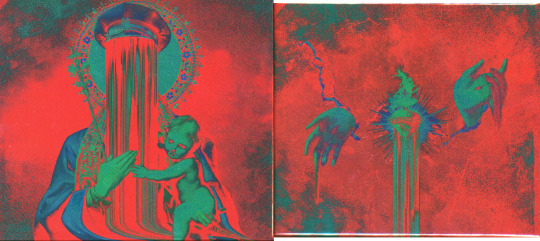
The Ninth cover is so fascinating because the veil makes me think of Binah, the pose and child makes me think of Mary & the Holy Ghost. But the scarlet colour screams Babalon.
Binah sephirah is the dark, receptive womb of creation, often associated with the color black, which symbolizes the hidden, formless potential from which all manifest reality emerges.
The veiled aspect of Binah is the concealment of divine mysteries and the incomprehensibility of the divine essence to human understanding. It suggests that the divine wisdom is veiled from ordinary perception and can only be understood through intuitive insight and spiritual revelation.
Babalon the Scarlet Woman in western esotericism is the Qabalistic path of Daleth (Translates to door, gate. This Path is the door by which the spirit enters the world. It is the third and final path to exist entirely above the Abyss (Da'at) in the realm of spirit). It is the path that connects Binah and Chokmah sephiroth (The 2 of them would be similar to Izanami and Izanagi in Shinto as the mother and father of all existence or Yin/Yang).
Daleth is also the Venusian Empress card in tarot. She is associated with fertility and pregnancy. Bab (as in Babalon or Babylon) in ancient Hebrew means Gate of God. This is the womb and Star Gate from which you are reborn as your true enlightened self (Rubedo/redness).
I always think Babylon's taboo is a reference to this. The "Ade due Damballa" chant repeated in that song is from Chucky and translates to: "Give me the power, I BEG OF YOU". I see it as asking Babalon to let you Cross the Abyss. I expand more on this in the 4th part of my symbolism analysis.
But look at Ruki performing it live with the red laser to the heart. So reminiscent of the album cover art:




Moving on to MASS and Blinding Hope:

The doves. In Roman mythology, doves were sacred to Venus. The dove's association with Venus can symbolize the divine aspect of love, representing unconditional love, compassion, and harmony. In mystical traditions, love is often seen as a unifying force that connects all beings with the divine source.
Blinding Hope lyrics: "This darkness blinds out our eyes. Crying out for a change, we take all this hope and fight. Come back to the light"
Venus is linked with themes of transformation and renewal, particularly in her role as the Morning Star (lucifer or Lucy) heralding the dawn (coming out of the Abyss). The dove's symbolism of purity and renewal reflects the potential for spiritual rebirth and awakening.
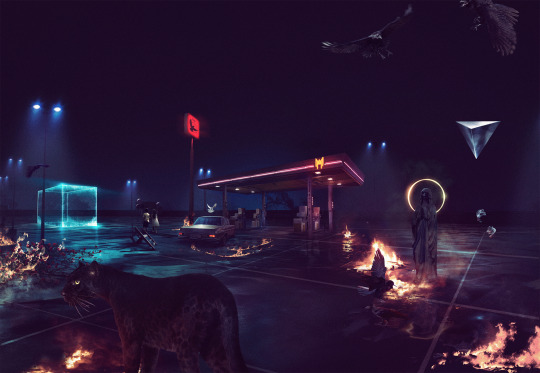
The Mass cover is a dream-like collage of imagery from the collective unconscious. Many unconscious parts have been integrated - I interpret the panther as tamed instincts. The fire is burning the Shadow. Death goddess is still there, but no longer a central figure, instead of holding a severed head, her hands are in prayer position. The work of contemplating Maranasati ("mindfulness of death" in Buddhism) is done. The cube is from the DIM cover but it's empty and clear unlike back then, when it had someone trapped inside. Lyrics from DIM scene: "We chase away the crows that gather around us. Their squawking cries ceasing, until every one of them has fled. Our utopia is so twisted and distorted that we have to sew it back together before it unravels".
The upside down pyramid is recurring image since the Magnificent Malformed tour, it is another depiction of the Feminine Yin and the subconscious.
Nox is the primordial goddess of the Night in Roman mythology. Nox lyrics: "Chased by silence. The drowning answers are always beautiful. What is left behind. Lamenting over common asuras".
(Common asuras suggest a broad existential/spiritual lamentation over the universal experience of grappling with desires, attachments, and the inherent suffering of existence.)
There is calm and serenity in the Mass cover image - compared to the storm and heaviness of Dogma. It's still Night but there is a lot of light. It is no longer crows surrounding our vehicle but the peaceful doves. (Although the crows are still there). All the pieces are gathered (the Shadow emotions are transmuted and the knowledge is acquired). Now we just need to finish the alchemical process. The gas station (with it's sign being the only scarlet red thing in the picture (the Red goddess is fueling our journey forward)) is the last stop before arriving at the destination.
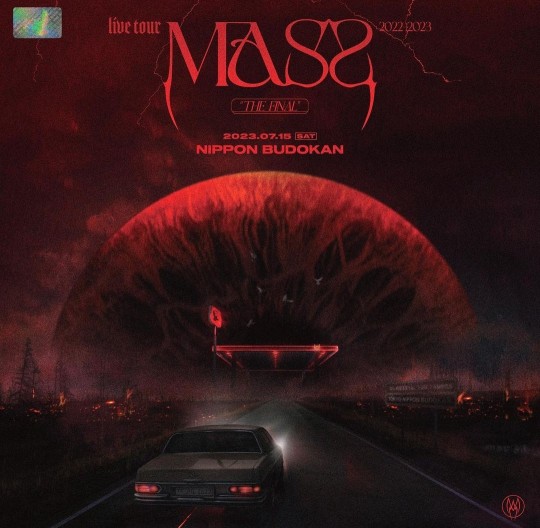
The red Mass Final poster makes me think of the path to Rubedo/Redness and the end of the individuation process. In Jung's words: "the Self...embraces ego-consciousness, shadow, anima, and collective unconscious in indeterminable extension. As a totality, the self is a coincidentia oppositorum; it is therefore bright and dark and yet neither"
Alchemy, individuation, enlightenment and crucifixion-rebirth of Christ ultimately mean the same thing.
The symbol of Self and the astrological Sun is a circle with a black dot in the center. The dot is the ego but the self encompasses it, as well as all the other elements, it is whole. The path towards this wholeness is a spiral.
Which brings me to Ruki's IG posts (some from as early as 2013):

(1) Spiral out - keep going. It's all individuation symbolism and alchemical colors.
(2) Bowie was known for being really into Thelema, (where Babalon is the main goddess) especially during his most successful years. Ruki is a huge Bowie fan and has posted about him multiple times.
Pic3 is from Black Moral - again the Sun symbol in the center is for individuation, and at the bottom - The Sun and Moon are are opposites that need to be reunited.
Pic4 is the Unkle - War Stories album cover. The most famous song on it is called Burn my Shadow, quite straightforwardly referring to Shadow as a Jungian term. (I really wanted to include these because I was listening a lot to both Bowie and this Unkle album during the time he was posting about them and the symbolism ties nicely to what I talked about earlier)
In the Mass tour final DVD teaser:

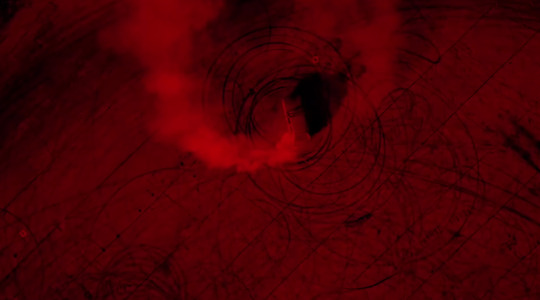
Pitch black night that we are moving through - doves heralding a new dawn - spiraling in Redness.
The Pale lyrics: "The dusk is disappearing, the shadow creaks in sorrow, until it disappears in my heart. The spinning night grows pale, as I embrace the meaning I’ve been looking for."
And finally the Mass Final DVD cover:

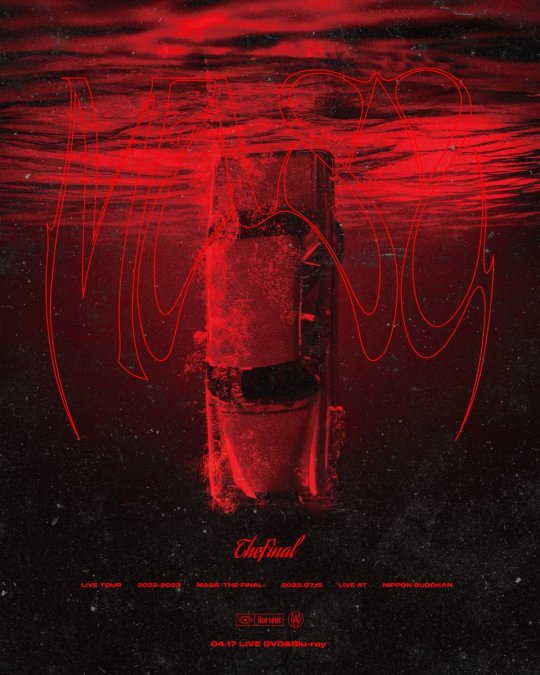
Pic 1 - A leap of faith. Releasing the need for control and surrendering to the divine, trusting the higher power. The circular red hue around the car and doves indicate the Goddess' presence. Water and sea represent the depths of the unconscious mind and its mysteries, as well as the interconnectedness of all life.
Falling lyrics: "To be reborn again, I’m gonna fall"
The water where we are falling has a circular red spot which looks like the Japanese flag. The red in the Japanese flag is called "circle of the sun." So, this image is referencing both the journey to Self as well as foreshadowing the next album which we know will be heavily influenced by traditional Japanese culture. (There is also a huge Japanese flag at Nippon Budokan where the GazettE insisted on performing MASS final)
.
Part 2 - The Yin Yang Guitars Part 3 - 13 stairs, Dawn and reddening Part 4 - Babylon, the Red Goddess Part 5 - Alchemy & Mass
68 notes
·
View notes
Text
Mon ami a émit une théorie comme quoi Yugo risque d'être corrompu par le statis des nécromes. Et en soit, il serait pas loin de la vérité vu que dans le premier teaser de la saison 4. On voit Yugo créer une lame de wakfu mais aussi une lame de statis.
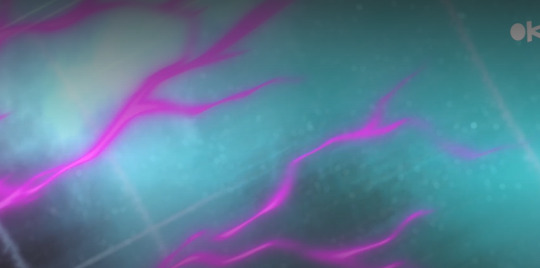


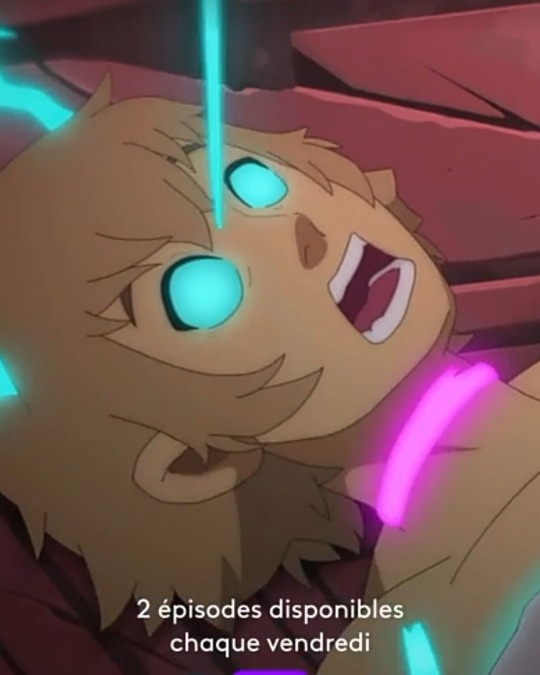
En revanche, il m'a aussi dit que le statis et le wakfu sont comme le yin et le yang. Ce qui veut dire que ce sont deux énergies qui s'opposent mais qui peuvent pas vivre l'un sans l'autre. Donc même si il y a des chances que Yugo se retrouve corrompu. Il peut tout aussi bien trouver l'équilibre entre le statis et le wakfu en lui et représenter l'équilibre entre ces deux énergies.
My friend theorized that Yugo might be corrupted by the statis of necromes. And in fact, he's not far from the truth, as in the first teaser for season 4. We see Yugo creating a wakfu blade as well as a statis blade. However, he also told me that statis and wakfu are like yin and yang. Which means they're two opposing energies that can't live without each other. So even if there's a chance that Yugo will end up corrupted. He can still find the balance between statis and wakfu within himself and represent the balance between these two energies.
45 notes
·
View notes
Text
Final Chapter Trailer Observations
I'M SO EXCITED FOR THIS MOVIE, Y'ALL!
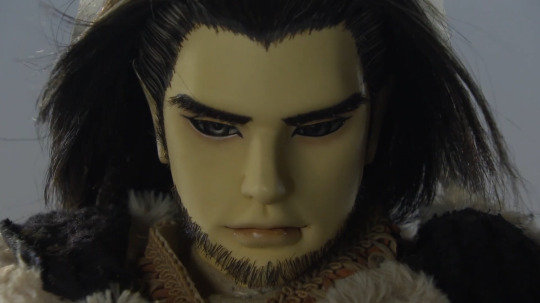
Shang looks like he's so done here, lol.
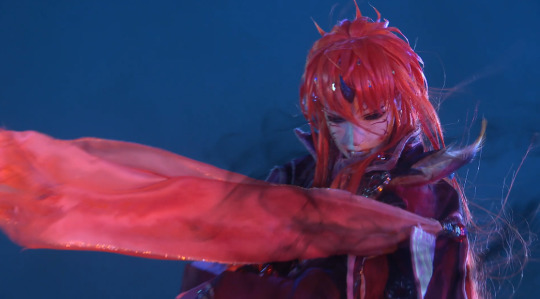
Lang woke up! And he's a demon again! (His self-image keeps changing from moment to moment depending on his mental state.) Based on the background, I think he's still in his dreamscape and is confronting whoever woke him up--see my earlier speculation about Chao Feng.
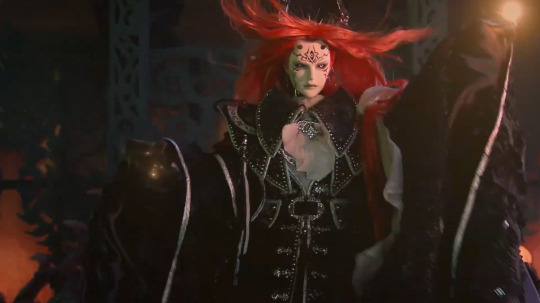
Azi doing some heretical arts. His profile on the movie website shows him with some kind of weapon that attaches to his gloves. This is probably from the scene where Lang confronts him and they fight.
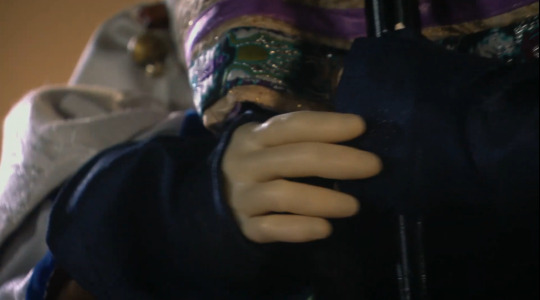
This looks like Juan Can Yun picking up his spear again, to which all I can say is HECK YEAH BABY LET THE LANCER FIGHT (plz don't kill him, Urobuchi).
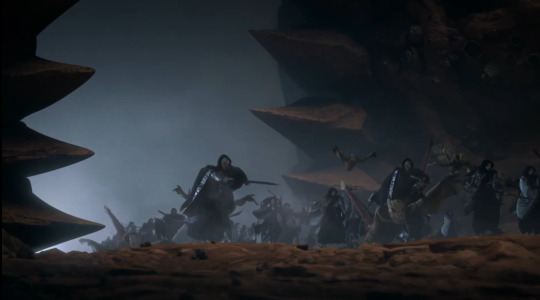
Since Urobuchi killed off all of the other named demon characters, it's just faceless mooks and han jiao pouring out of the abyss into the human realm.
How do they keep the han jiao from friendly fire, anyway? Do they always aim for the weakest or something?
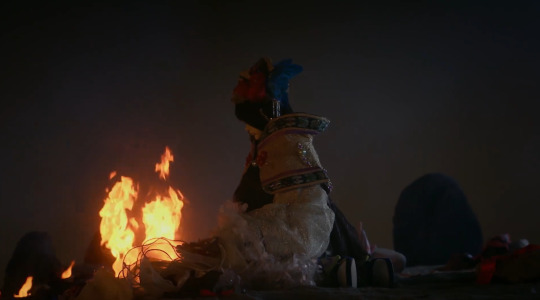
Dan Fei slumped in grief. JUAN CAN YUN HAD BETTER NOT DIE IN THS, OKAY? (My money is on Bo Yang Hou not surviving, though....)
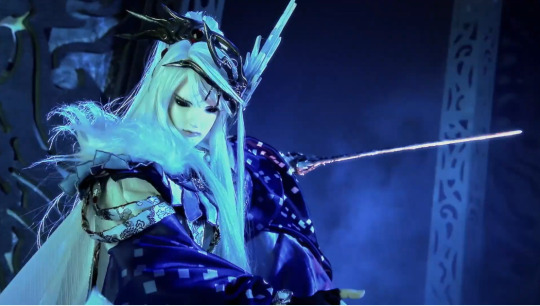
Lin fighting in the Demon Court. This looks like his own sword Yan Yue and not the Ling Long Jian, but it's hard to be sure from the angle. I hope this is Lin fighting the Demon King because that would rock.

This is the floor of the Demon Court, on fire. I think the red wooden thing is a piece of ornate frame or decoration from the walls? Everything is on fire - presumably Lang, but who knows, maybe the Demon King will have fire powers to contrast with Lin's ice theme.
Also, those casings on the floor... please be another gun please be another gun please be another gun--
Alternate theory: the wooden frame is one of the wheels from the cart that Bo Yan Hou's part of Hu Yin Shi were carting across the Wasteland of Spirits. I'm not sure how they would have gotten that thing this far, but one way or another, we will see that cart and its contents again, and it's gonna be awesome.
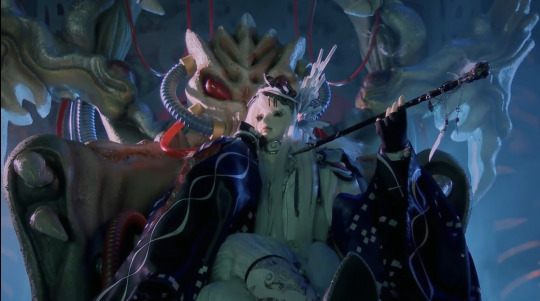
SIR. SIR. SIR.
Lin: my city now
Well, I guess we know what the Demon King's throne looks like! God, what a power move. I love this asshole so much.
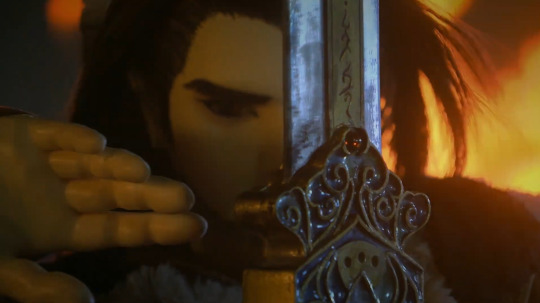
We all knew that Shang was going to end up wielding the Lotus Macguffin sword, right? The one with the power of 30 Shen Hui Mo Xie (i.e., just about all of the swords in the Index) combined? The deus ex machina that his bestie Bai Lian made especially for him? Yeah. That's what I thought.
Anyway, it seems like Shang et al.'s expedition to rescue Lang from the demon realm will not go as planned. Lin probably stays behind to deal with the Demon King while Shang returns to the human realm to confront... demon god Lang as the final boss? Locust? the entire demon army? All of the above? The only thing for certain is that THE LAND IS CLOAKED IN DEEPEST BLUE!
(It's not visible in this frame, but Shang is bleeding from the mouth, so this is not the first exchange of blows, lol.)
10 notes
·
View notes
Text
youtube
i will try to finish it tomorrow or later but i don't think i'll film the rest!
#okenki#illustration#art#original art#ocs#drawing#msat#yappy#yin et yang#yes it is my babygirl#watercolours
9 notes
·
View notes
Text
Yin et Yang
7 notes
·
View notes
Text
Yu-Gi-Oh GX and Alchemy: The Nigredo

So Yu-Gi-Oh GX is the first successful Yu-Gi-Oh spinoff after the original manga and anime ended, and it began two trends, one a long line of anime spinoffs that would continue to make anime original stories revolving around the trading card game and two that each new anime would focus on a new method of special summoning.
When creating an all new Yu-Gi-Oh story with only some input from the original mangaka, Hikokubo Masashiro stated GX focusing on fusion summons was an idea the staff came up with. Hikokubo felt that polymerization and fusion summoning were rarely used during the duel monsters era, and felt that it was a very underutilized but incredibly interesting mechanic that was unique to Yu-Gi-Oh! When he proposed the idea to have the new summoning be fusion focused, Takahashi loved the idea and was extremely enthused by it.
Now the question before we even begin is why am I analyzing Yu-Gi-Oh? It's because it's a shonen anime and this is the blog where we overanalyze shonen.
Yu-Gi-Oh is literally no different from any anime with a power system, it's like Hunter x Hunter except instead of using an ovceromplicated nen system with a lot of rules, the characters instead play an overcomplicated card game with a lot of rules. The same way a character's nen is thematic and telling of their character in Hunter x Hunter, their cards and dueling style is thematic to them in Yu-Gi-Oh! If you can just get over the fact that it's kind of silly everyone's using cards to fight, it's the same as any other shonen anime. They're all using magic cards to fight each other with magic, the cards are a power system, and the power system means something in regards to the characters in a shonen anime.
By Yu-Gi-Oh GX using fusion as its focus summoning method (combining two or more monsters to summon one) it's also thematically about alchemy - specifically physical alchemy solve et Cogaula. Latin for dissolve and coagulate, the process in which through four elemental stage silver is refined into gold and a philosopher stone is created.
The main character of Yu-Gi-Oh GX is also on a journey to become an alchemist, and create the philosopher's stone / the elixirof life. He is also a duelist who uses an archetype known as the "elemental heroes" that fuses heroes based off the four elements (fire, earth, water, air) and also yin and yang (light and darkness) into different combinations to create stronger monster. A character who's strongest card at the end of the first season is called "Elemental HERO Elixir" and requires featherman (wind), burst lady (fire), clayman (earth), and bubbleman (water) to fuse together in order to summon. A character who's art depicts a man wearing gold armor surrounded by the four elements of the Yu-Gi-Oh cardgame in the background.
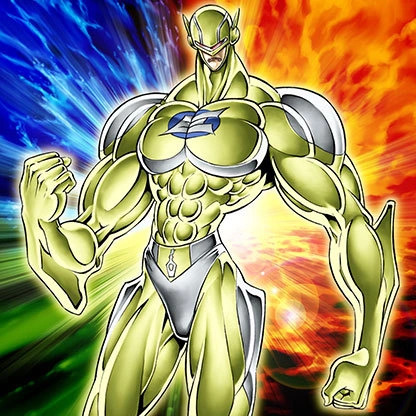
However, that's only in season 1 and Judai's journey stretches for four seasons. I only used elixir as an example to show that fusion and the elemental hero archetypes are both things that connect Judai to alchemy, and why his journey is to complete the four stages of alchemy and the creation of the philosopher's stone.
I'm also making this post for Kate who is the only person that will read it that Yu Gi Oh GX incorporates Alchemy research as well as A Song of Ice and Fire and RWBY. Because just as with those shows the formula of "Solve et coagula" is stuck to, though Yu Gi Oh GX uses "Fusion" as its main metaphor for dissolve et coagula.
Anyway, Yu Gi Oh GX has four seasons, with four main story arcs which follow the four stages of Alchemy to a T.
The Seven Star Saga: Nigredo
Society of Light Saga: Albedo
Dimmension World Saga (Citrinitas)
Darkness Saga: Rubedo (Red)
These four stages also proceed in order of four elements, which as I said is the same as the four elements of monster cards in Yu Gi Oh.
Fire
Water
Earth
Air
They also all correspond to four colors as long as we're getting the basics out of the way, because color symbolism is important to aclhemy too. These are:
Nigredo / Black
Abledo / White
Cintrinitas / Yellow
Rubedo / Red
For more proof that Alchemy is baked into the DNA of this show, here's a group shot of what are basically the main characters for opening two, and look what colors they are wearing.

Judai - Red / Black
Fubuki Tenjoin and Asuka Tenjoin - White
Manjoume - Black
Sho, Misawa, Kenzan - Yellow
There's also three main dorms Osiris red, Ra Yellow, Obelisk Blue and yes Obelisk Blue is Blue but the uniforms are Blue and White and they're even replaced by the white dorm in the second season. Characters even change what colors they are wearing to indicate progression in their arc, Fubuki is introduced to us as Darkness possessed by his inner darkness and then switches to an all-white uniform by season 2 nigredo -> albedo. Manjoume sheds his blue uniform for Black and stays in the Osiris Red dorm for three seasons after losing his elitism -> entering the nigerdo stage.
Most importanly though Judai our alchemist is the only character to wear red and black, as Red is the color of the philosopher's stone which is Judai's main goal but Judai like Manjoume also wears black underneath to signifiy he too is going through the nigredo stage. Judai is an alchemist attempting the great work of self, and he must start at stage one - Nigredo.
So, to begin with what is Nigredo?
The Alchemy of Darkness - Nigredo
In alchemy, nigredo, or blackness means putrefacation or decomposition. Many alchemist believe that as a first step in the pathway to the philosopher's stone all alehmical ingredients need to be cleansed and cooked into a uniform black mater. This is sometimes called "blacker than the blackest black>" Nigredo means putrefecation and decomposition.
It's ruled by the planet Saturn and connected to lead, which is ocnsidered to be the basest and most impure metal. Metaphysically, it is tied to the dragon and the destruction of the dragon, symbolized by decapitation and the skull of the raven.
This is an unpleasant and often violent process, because one must face one's darkest flaws. Because one 'reaps what ones sows" and noen gains likel only to what one loses accoring to the Laws of Isis spoken by the Angel Amnael, to change into a final nature one must destroy its flaws - and thus its whole property - so that it might be remade again. In a lab one must cook all components down to a uniform black matter, which takes no less than fourty days - or one year of high school.
Judai begins his journey wearing inverted colors, black school uniform on the outside and red on the inside. He also is marked in the first episode and season 2 as the Fool. Saio a character with the ability to see the future who plays a tarot themed deck, sees Judai as the fool, the wildcard in which fate can change.
The fool's journey, and the process of alchemy are similiar, they're both things Jung references for the development of the self. Tarot is season 2 territory so all you need to know right now is Judai is the fool in both senses of the word, he is at once innocent and ignorant. His innocence inspires people, and his ignorance causes problems, though that won't be highlighted until season 3. The fool is on a journey to gain wisdom, which is why Judai's first action in the anime is meeting up with a magician (Yugi, who's ace card is the black magician) who gives him guidance by giving him winged kuriboh.

The story of the Tarot is actually a paralel to the alchemist's journey, and the Fool--who begins his trek untouched by the world around him because he sees and understands nothing--is the fledgling alchemist, with his powers and potentials all untapped and unknown. This is a childlike figure in many ways, and the symbolism here is capable of being both that of innocent oblivion and the callous disregard that children (and Judai) are also so capable of. In fact Judai's entire character revolves around the dual faces of the fool, that innocence and ignorance can be the same thing, and that jUdai may not mean harm in his ignorance but that doesn't mean it's not harmful and his ignorance is why he needs to go on a quest for knowledge in the first place.
And Yu-Gi-Oh GX is primarily about Judai's journey. There are other characters who grow up besides Judai, but it is primarily about Judai going on a journey from childhood into adulthood. I will be mentioning other characters here, but when they change it's usually meant to reflect Judai in a way too.
Either way, Judai's role as the alchemist is indicated right away in his first duel, as he uses flame wingman - his favorite card a fusion monster that is specifically a fusion between man (featherman) and woman (burst lady) in order to cook crowler's antique gear soldier which is made of metal. This not only sets up the formula for how he'll win every major duel in the show, fuse weaker monsters into stronger mosnters. It also serves as some early, early foreshadowing for the appearance of the Rebis the fusion of man and woman that happens in the final stage of alchemy. The Rebis in this case being Yubel but that's season 3 territory.
Flame Wingmna's appearance is foreshadowing for Yubel, it's also pretty clearly a Rebis, it's a fusion of a featherman and burst lady, and it also has a dragon head appearaing on one of its arms. It's also the first succesful fusion / attempt at alchemy we see Judai perform in the show and it's what lets him win his first duel. It even appears in front of the moon because Judai played Skyscraper, switching the time in the duel from night to day.


However, alchemy doesn't just happen once. It's a process of continual refinement where the alchemist dissolves and coagulates over and over again in order to purify himself, the same way that Judai's entire sidedeck is countless different attempted fusions of his elemental hero monsters, each fusion serving a purpose in a different situation.
Chemical weddings, the union of opposite elements don't happen once in this show but over and over again. This is important to point out for all three seasons to show how much alchemy symbolism happens in this show and how much alchemy is a continual process.
The Stages of Alchemy
However, before continuing forward I need to say Yu Gi Oh GX is a pretty weirdly paced show, the first 100 episodes or so are setup for a dark deconstruction that happens in the next 90 after that. So Season 1 and Season 2 are both a lot of set up for both changes and alchemical processes that will happen mainly in Seasons 3 and 4. Which as I said, chemical weddings happen multiple times not just once and alchemy may have stages but it's not necessarily a strictly linear process. The series however does still follow the 4-part structure of alchemy and even makes specific references to medieval paintings which describe the alchemical processes.
There are also several allusions to the Splendor Solis - 22 illustrated plates which describe the alchemical process [source]
Which are divided into 4 groups like this:
4 introductory plates - they present the protagonists of the alchemical journey.
7 Parables - they describe the alchemical death and rebirth
7 flaks plates - they describe the alchemical process from a practical point of view
4 final plates - they describe the alchemical process from a spiritual point of view.
Seasons 1 and 2 being one long introduction for the second half of the anime, both include references to the four introductory plates. We'll be covering references to those two as we continue our journey into season 1.
I bring this up now because in episode 3 we are already at our first reference to Splendor Solis, Plate 4 the meeting of the king and the queen, the male and female, the yin and yang, the sun and the moon. The opposition of two equally matched forces, what most call the chemical wedding.

Judai and Asuka in the third episode duel each other over water with both of thme standing on boats. Asuka is the queen of the obelisk blues called that by several characters, and Judai not only quickly becomes the best male duelist in the school he's also on his journey to being a king in season 3. Judai's flame wingman (fire) actually clashes with her Cyber Blader (ice) during the duel atop the water.

Asuka primarily wears white, which is associated with Abledo. She is also associated with water and ice (she uses an ice deck when brainwashed by sartorius in season 2). In Jungian symbolism, the Albedo stage of alchemy is also tied to the union of anima and animus. There will be more time to cover this in my season 2 meta, but just as a starter Asuka in this episode is basically set up to be a female Judai, something compounded upon later in the season.
The basic premise of this episode is that Cronos puts a fake love note from Asuka to Judai in order to try luring Judai into a trap to visit the girl's dorm at night. When Sho gets lured by the trap, Asuka thinking very much like Judai does, doesn't see a potential romantic partner but a potential duel rival.
Asuka's true love isn't boys, but dueling itself much like Judai who for the first two seasons seems either oblivious or weirded out by women showing affection for him and who's primary method of making friends and connecting to people is by dueling others.
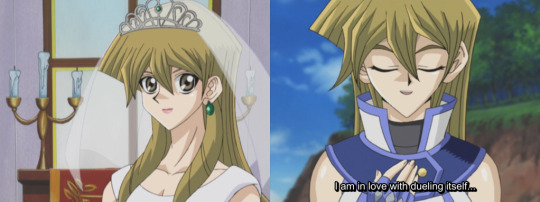
Judai and Asuka's first meeting isn't necessarily a romantic chemical wedding, because one happens in season 3 and it's with someone who's not Asuka - but it is still a union of opposites. Anima and Animus is something I plan to cover more in season 2 but basically Jung divides the psyche into two part, the feminine aspects of personality and the masculine aspects and makes the observation that most men aren't accustomed to their feminine side and vice versa. Men must therefore come into touch with their feminine side and integrate their feminine traits into their everyday life in order to become fully realized people.
Judai is basically dueling with the female version of himself, another person who loves dueling above everything else and uses it as a way of conencting with other,s and Asuka even pulls a Judai-like move, she threatens to get Judai and Sho expelled to extort a duel out of Judai because she wanted to size him up as a potential dueling rival.
Asuka also plays the role of the high priestess in the fool's journey, to Yugi's magician. As it's through his encounter with Asuka that Judai gains passive guidance for what his role will be in season 1 - as she's the one actively looking for her brother Fubuki which will lead Judai to the seven stars plotline. In fact, while Judai came to the anbadoned dorm because him and Sho were sharing scary stories, he sticks around and explores it deeper specifically because he heard Asuka make a mention that her brother went missing there.

This leads to the introduction of shadow duels - duels where characters bet their souls on the line and the consequence for losing is being consumed by darkness, otherwords a failure in alchemy.
The entirety of season one is basically one long pattern of Judai who only duels for fun and to connect to other people learning that there are darker sides to dueling (shadow games) and going through one long process of realizing that not everything is for fun and there are times you duel with your life on the line. Or at least, that's what he should be doing but a lot of Judai's development is stalled until season 3. However, that stage is still set up here.
Judai does not really grow a lot in season one, but we have other characters going through their own mini-alchemeical journeys in order to reflect Judai. For instance, each season Judai has a rival / foil that contests with him for the hero role. In season 1 it's Manjoume who thinks he's the one more set up to inherit the next king of games.
Manjoume goes through a pretty common arc for shonen characters. He's suddenly defeated by the appearance of a new rival, he loses all confidence in himself, he goes off somewhere else to train and then returns to defeat the rival that knocked him off his pedestal.
However, that usually happens to protagonists. Manjoume, a rival character, goes through more of a journey than the main character of his own show at least in season 1. Manjoume follows the nigredo formula pretty much to a T.
We see Manjoume break down completely. He loses to Judai even after getting cards from Crowler (his Dragon card is even killed by Judai) he then has a mental breakdown and tries to cheat against Misawa only to lose again and leave the school entirely. Even his deck goes through the process of dissolve and coagulate, as he has to get rid of his old deck and then find 40 new cards in the northern tundra and put together a new deck from scratch. He even returns to Duel Academy wearing black and purple after having gone through the process of breaking down entirely and reforming to signify his change in the nigredo stage.
This is the kind of arc and internal struggles you give your main character so we find their growth and journey compelling, but Judai's basically already a dueling prodigy he doesn't need to become stronger as a duelist. In fact Manojoume's internal insecurities are more at focus in this arc than the main character's too.

Judai is usually the character who duels the main boss, but in season 1 and 2 he rarely if ever feels the pressure to win the same way that Manjoume does in just this one duel with relatively little stakes. In fact if alchemy especially nigredo requires boiling and pressure in order to change the chemical composition of the metal that they're currently boiling, Manjoume is more emblematic of that chemical change -> heat and pressure allowing him to metamorphosize into a new person.

In fact Judai purposefully doesn't talk to Manjoume during this scene because he doesn't feel like there's anything he could say on an emotional level that would help him b/c Judai isn't really mature enough to understand that feeling of responsibility and pressure Manjoume is struggling under - he just tries to work it out in a duel instead.
Season 1 is all about Nigredo, about plunging into darkness but Manjoume who plunges into darkness to find himself and to an extent Asuka who journeys into the darkness to find her brother are the oens who actually experience a change while Judai remains a mostly static character. He is the impetus of change for both of these characters, but he doesn't really change himself just yet.
So Asuka has an exernal objective -> find Fubuki, and Manjoume has an internal flaw -> His insecurity and inferiority complex and both of them need to plunge into darkness in order to remedy these things. Judai doesn't have any objective at all, but because he comes into contact with Asuka and Manjoume he helps Asuka with her quest and Manjoume with his internal insecurity.
From early on Judai despite literaly fighting with a deck called the "Elemental Heroes" is more of a designated hero, then an actual hero. As I pointed out above other characters struggle with the kind of insecurities that protagonists usually struggle with. Judai doesn't need to learn to believe in himself or be a better duelist, he's already a dueling prodigy, that's Sho, and Manjoume's struggles. Asuka is the one who has a personal motivation to save someone because she wants to save her brother, Judai only helps because he wants to help Asuka. Judai is picked to fight once the seven stars start appearing not because he is the most heroic character, but because he is the best duelist.
It's not that Judai doesn't help when someone asks him for a helping hand. He always gives his help when asked for it, but otherwise he's an incredibly passive character who continually "only duels for fun" even when the stakes get higher. He only feels the pressure to win that Manjoume did for one episode after the gauntlet of Darkness Camula and even then it's immediately resolved with a duel against Kaibaman.
However, despite not having the things usual main character have, an outward objective, or an obvious internal flaw that he needs to fix or boil away in the alchemy sense he's still the central character of the show. Fubuki is Asuka's brother, and yet when he appears again it's Judai who duels him.
Yami no Game - Versus Darkness
The first instance of actual plot in this show happens in episode 29 (Yu Gi Oh is a well paced show / sarcasm) when Fubuki / Darkness appears as a member of the seven stars, to challenge Judai for his key, kidnapping his friends and holding them hostage in a volcano for an ante. This entire duel is steeped with alchemy symbolism and is to be honest one of my favorite in the series. It's also Judai's first real "yami no game" if one counts the duel at the dorm and the duel against Jinzo as warmups.
To recap from above, Nigredo is the first step of alchemy, it's usually associated with fire, the color black, and the death of a dragon. This duel takes place in a volcano. A volcano where dragons made of flame rise up from the lava, and Judai's opponent Darkness walks right out of the fire to face him.
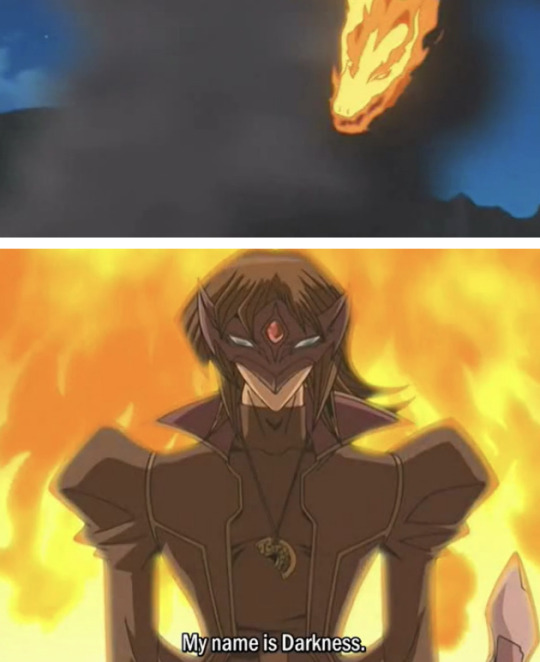
Darkness not only hits all the symbols for the first stage of alchemy, his deck also corresponds to this stage. He's running a red eyes black dragon deck, a deck who's ace monster "Red-Eyes Darkness Dragon" gets stronger for every single monster in your graveyard. If Nigredo is initiated by the death of a dragon. They fight on what is basically a graveyard of dragons with dragon spirits constantly jumping out of the lava, the dead spirits empowering Red Eyes Darkness Dragon even further.
Red Eyes Darkness Dragon - Cannot be Normal Summoned/Set. Must be Special Summoned (from your hand) by Tributing 1 "Red-Eyes Black Dragon". Gains 300 ATK for each Dragon monster in your GY.
Fubuki arrives in practically a storm of fire, promising to melt everything away if Judai doesn't take things seriously. He even calls Judai half-hearted for not realizing what is at stake here. Once again he's applying heat and pressure to try to force a transformation inside of Judai.
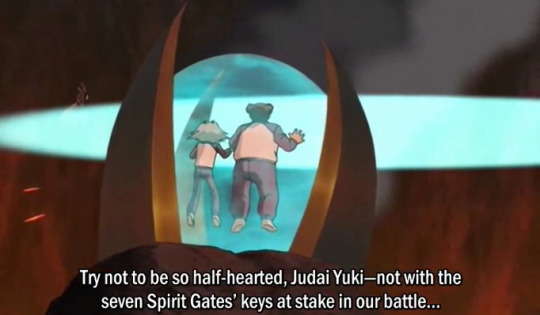
It is the first and last time for awhile someone challenges Judai seriously on this level (as most of the seven star matches bar Camula get kind of silly after this) but it also incorporates the Nigredo and the Work of Self, 'if you cannot overcome the blackness and despair of your own self, you will be burned away'. The volcano, the dragon graveyard, red eyes darkness dragon all incorporate the image of the skull, the dragon and the fire which reduces one to black matter.
In a normal narrative this is where Judai would succumb to the pressure like Manjoume did and start to take things seriously, but once again Yu Gi Oh Gx is building up a three season long-con. The one who changes isn't Judai, but rather Fubuki who's internal darkness is purified by the end and we see him return to his usual self, though he'll call upon the darkness again in season 2 and then season 4 because purification isn't' a one and done process.
We're shown other characters around Judai changing, and Judai often being the impetus for that change, but we're not shown exactly why until all the way in episode 45 when Amnael decides to play his hand, because Yu-Gi-Oh Gx is a well paced show (sarcasm).
If we focus on the duels that develop Judai as a character it goes a little something like:
1st duel against crowler establishes his use of fusion
1st duel against asuka - chemical wedding / anima + animus
1st duel against zane - establishes relationship with sho
3 duels against Manjoume - Manjoume's arc
Judai vs Misawa - More for Misawa's arc because it teaches him that isntinct can win against obsessive thinking over strategy.
Judai's 3 shadow duels (vs Titan, vs. Jinzo, vs. the Gravekeepers)
Finally, vs. Darkness / Fubuki
The only duels that really are about Judai as a character are Yami no Games, the ones where Judai is forced to bet his life on the line in a duel because those are the duels that challenge his philosophy that dueling is just for fun and his desire to duel purely for his own entertainment. Basically every other duel that Judai gets into up until this point is for other characters not him, only the Yami no Games int true Nigredo fashion push Judai's arc along as he slowly realizes there are times where he needs to carry responsibility and weight on his shoulders and keep going.
When the pressure of dueling becomes too much for him after Darkness and Camula he does receive an alchemcial bath, in the form of a hotsprings episode where he gets to fight Kaibaman in a low stakes duel which relieves him of the pressure temporarily. Kaibaman is also dressed in white, and plays the blue eyes white dargon the counterpart to the red eyes black dragon.
The impetus for this episode is a dream where Judai sees himself losing against an unknown shadowy dragon, which causes both of his friends to burn away in fire while he's consumed by the darkness as a price for losing the yami no game.

In those last minutes too Judai's more concerned with his friends who are crying out for his help then he is for the fact that he himself is being consumed by the darkness. Something which will come back in season 3, because Seasons 1 and 2 are excellent at setup and foreshadowing if nothing else.
Foreshadowing because there is a scene where Judai's friends do burn away and he does sink into darkness, his nigrido and all his anxieties reflected in this dream here prove true but once again it happens in season 3.
Things that seem like they are neatly resolved in seasons 1 and 2 will always be called back to in Season 3. Judai goes through several mini arcs of "I need to take dueling more seriously" only to revert back to his usual carefree irresponsible attitude, because in seasons 1 and 2 the consequences for Judai not taking thing seriously and messing up aren't as severe as they'll eventually be.
Judai is called to in his Yami no Games plunge the depths of his own personal darkness, Daitokuji leads him to three shadow games to make him realize there are games where real life people can get hurt - Fubuki yells at the top of his lungs not to half-ass this duel or his friends will burn away into nothing. Judai is called to explore those depths of darkness... he just doesn't. Manjoume does, Fubuki does, Asuka does, even Sho and Ryo have an honest conversation about their relationship as brothers when Camula holds Sho hostage so Ryo will lose the duel.
I'd argue there are hints that Judai does have an inner darkness that he's refusing to examine all the way back in season 1 too, because the foreshadowing in this show is excellent. In episode 5 when they're all sharing ghost stories, Judai shares a story about how he thought he could hear the voices of his duel monsters when he was asleep.

Only for Judai to jokingly end the horror story by declaring that he didn't see a thing.

Those who have watched season 3 know that this is a bald-faced lie, because it was right around that age that Judai was given a haunted card by his father that put all of his friends into comas and made it so no one wanted to duel with him let alone be around him. Judai used to be able to see card spirits, until the traumatic incident of one dark card spirit made him cut off his ability to see them entirely. Judai tells Sho half the story, and then blows the rest off as a joke.
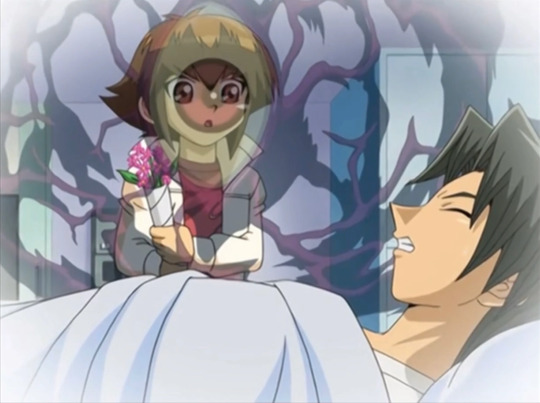
This scene is pretty clear season 3 foreshadowing, but also in a sense of alchemy, Judai is failing to confront the darkness here because he remains ignorant of his repressed childhood memory. He muses for a second on the fact that he can remember hearing card spirits when he was younger, but doesn't reflect on why he stopped hearing them because he's coping poorly with that traumatic childhood incident still. Which is why he is so stagnant because even when he's given opportunities too - he doesn't reflect on his past, or even reflect on who he is whatsoever.
This small detail of his backstory doesn't come until season 3 so technically I'm spoiling you, we're given no information at all in season 1 why Judai loves dueling so much and why it seems to be the only thing he cares about not because the writing is bad but because Judai himself never reflects on those things.
As Judai plunged into the world of Yami no Games, he could have reflected more seriously on these things, but he didn't because Judai is also more concerned with other people, and forced to duel to save other people first before himself.
Judai fails to commit nigredo, and this normally would result in reverse alchemy or even character stagnation but that doesn't happen until season 3 - mainly because in season 1 Judai has a mentor to sweep in and kind of fix his mistakes for him.
There's a whole bunch of duels in between this, but really Judai's next plot relevant duel is episode 44 the Seventh Shadow. When Daitokuji goes missing the gang goes out searching for him, only to find that he's facing Daitokuji as the alchemist Amnael and the sevenths star.
There's a billion alchemy references in this duel, because as I said Judai has only three really plot important alchemy duels this season the first being darkness, the second amnael, and the third Kagemaru and so all the symbolism is frontloaded into this one.
First off, Daitokuji carries around an emerald tablet for a millenium item gifted to him by Kagemaru and he also uses this symbol - which resembles the alchemy symbol for the sun, but also a traditional depiction of an ouroboros a snake eating itself.

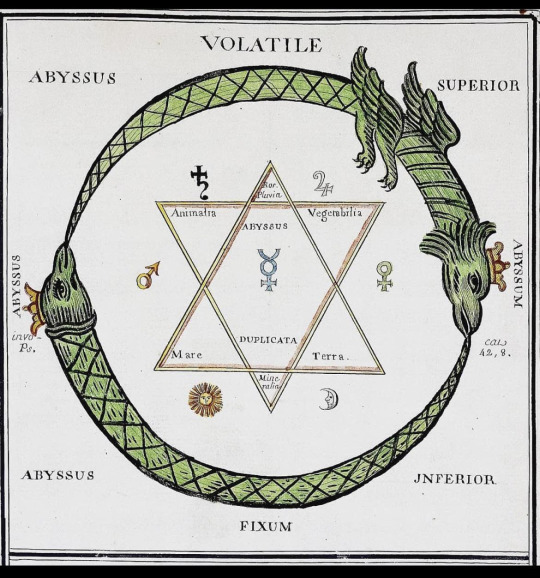
The ouroboros a symbol that appeared in alcehmy in Graeco-roman egypt, the same era that the Amneal Story appears from. A symbol which ties to the sun, mercurius (hermes) and his caducous staff which contained a male and female snake interlaced.
In Egypt the sun went on a journey to the underworld every night, only to come back to the world of the living every morning. In the duel itself, Daitokuji is long dead, and Judai must in a way kill his mentor as apprentice in order to replace him as alchemist. Daitokuji also comes right back immediately as a ghost, because life and death are an eternal cycle like the ouroboros itself.
Daitokuji goes by the name of Amnael an angel who appeared before Isis to reveal the great mystery to her. Amnael becomes a lover to Isis and reveals the secret to her, but first makes her swear a mighty oath by "fire and water, like and darkness, by fire, water, air, and earth" and a variety of Greek and Egyptian Deities.
The great secret in question:
“So go then, my child, to a certain laborer named Achaab, and ask him what he has sown and what he has harvested, and you will learn from him that the man who sows wheat also harvests wheat, and the man who sows barley also harvests barley. For a nature rejoices another nature, and a nature conquers another nature.”
In other words the great secret of alchemy is that you reap what you sew. In other words alchemy, like chemical reactions is all about actions and consequences.
This also ties to the phrase "as above, so below" which is chanted constantly in the two episode duel against Daitokuji. A phrase which is on the emerald tablet, (borrowing this from Kate). The emerald tablet is also wielded by hermes, so once again, greco-roman / egyptian alchemy lore.
"That which is above is like to that which is below, and that which is below is like to that which is above."
Things in the macrocrosm are mirrored in the microcosm, or in other words BE THE CHANGE YOU WANT TO BE IN THE WORLD. You have to change yourself before you can change others. The personal change that an alchemist goes through in acquiring the philosopher's stone and finishing a chemical wedding will radiate out to the rest of the world.
This is the role that the master alchemist gives to his apprentice.
Amnael and Judai's duel is basically a crash course of alchemy for dummies. Amnael's card archetype the Alchemy Beasts uses a distillation to summon seven different alchemy beasts which resembles the seven step process of alchemy.
Aretos the time
Ekanos the Mercury
Leon the Lead
Moonface the Silver
Ouoroboros the Bronze
Salamandra the Steel
Golden Homonculus
Coincidentally the number seven shows up a lot this season. The seven stars are the duelists that the main characters have to face in yami no games, probably a reference to the fact that there are seven heavenly bodies in the ancient medieval world, saturn, jupite,r mars, venus, mercury, moon, and sun which also correspond with the seven steps of refining metal into gold listed above. Sun being gold, and again sun being associated with Judai.
While also using support spell cards that reference the nigrido, albedo and rubedo. Before finally using the Macro-cosmos card... which is again covered above changes on the microscale effect the macroscale.
All in the world originates from a single substance altered in various ways to form heaven and earth. Even the world of man known as the microcosmos and the world of the heavens known as the macrocosmos. So, humans and outerspace are connected?
Amnael then procees to push the sun through three phases, helios - the primordial sun, Helios - Duo Megistus, and Helios - tris magestius. The second stage being a reference to this.
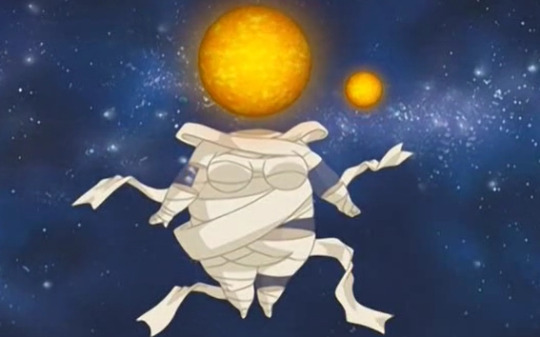
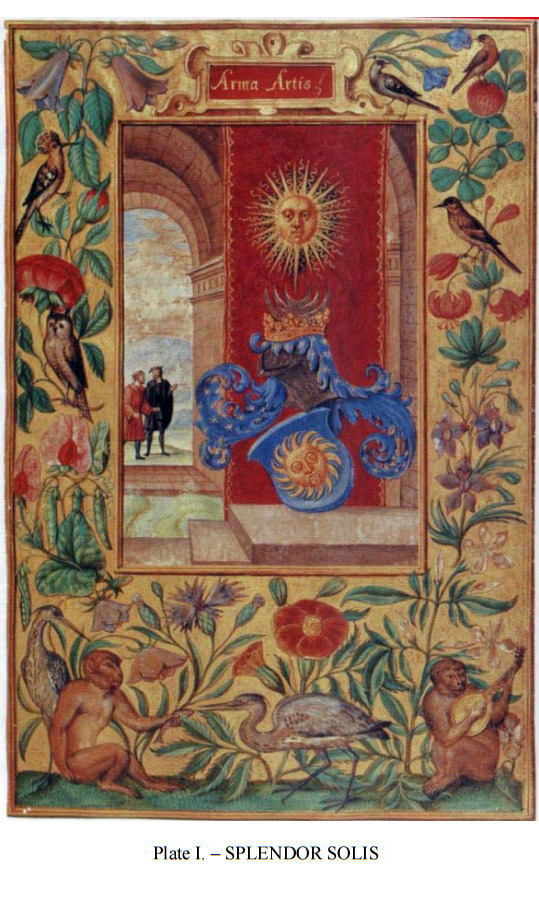
Outside the building where this standard is housed are two men. Their body postures might suggest they are teacher and initiate. The master points to the standard, separated from them by swirling and overflowing waters. There is also a three-step platform leading up to the standard, possibly reflective of the tria prima which all alchemical substances are made from; Paracelsus defined these as Mercury (Spirit), Salt (Body), and Sulfur (Soul)
The master is teaching the student - there are two men, two suns, ad even two babboons in this piece. Sharing and art. Giving and taking. The teacher shares, and the student takes, indicative of the fact this is Daitokuji's final lesson.
In alchemy three suns also appear to show the three stages of aclehmy, the blakckun, white, sun and red sun. The black sun is considered important for the dissolution stage of alchemy. The man holding the flask contianing the golden liquid, made from the four elementsor rather Plate 2 is also referenced in this duel.


Daitokuji is the old man with the flask, the duel also concludes with an elixir created from the four elements of nature. Judai creates elemetal hero elixir by fusing four elemental heroes of different elements in his graveyard. After her reflects upon what he's gained in the past year at Duel Acamdey compared to what he didn't have before - friends.
At which finally Daitokuji elucidates why he chose Judai of all people as his chosen pupil.
"Alchemy 's ability to change all into gold is merely a superficial phenomenon. It's true aim is to change the hearts of people into purer, nobler things."
Judai as we'll find out in season 3 started out the story as a friendless loser, and his desire to connect to others through dueling, causes him to purify the people around him by enduring many trials and tribulations for their sakes.
Amnael is also the first to notice the potential of Judai, and that this potential lies within Judai's darkness. Though, even though Judai is pushed to do a little self reflection in this duel (admitting to himself that he was lonely before he came to duel academy and this is the first time in his life he's had friends) he doesn't actually look inside that darkness towards those repressed childhood memories we were looking at earlier.
If anything while Daitokuji's lesson is a short-term fix, like a bandage over Judai, it doesn't actually help him in the long-run. This is because the reason why Judai is succesful in this season is not really anything of Judai's doing, but because Daitokuji the master rigs it for him. Daitokuji is the one who prepares challenges to increase Judai's strength at dueling, Daitokuji is the one who hands Judai the emerald tablet that lets him make a philosopher's stone during his duel with Kagemaru, Daitokuji is the architect of most of the plot in season 1 and Judai just kind of passively follow his script. Judai is not the alchemist in the first season, he's the apprentice and basically he only makes his first step in his journey by consuming his master and that's in episode 45, when the season is 4/5ths of the way over.
Judai is the alchemist, he's supposed to change others by forming relationships with them the same way that he can fuse two monsters together to form a stronger monster. However, he also has to change himself in order for that to happen and Judai doesn't change through seasons 1 and 2 - he gets by in the short term but it costs him long term development.
Because the duels Judai gets into are always about other people and not about himself. Even the climactic duel of the season against Kagemaru, Judai barely knows who this guy is. Judai's not there by choice, Judai is there because Daitokuji set things up so that his student Judai would defeat Kagemaru the main villain.
Judai's not dueling for himself so we barely learn anything from these duels, and Judai still doesn't really take this duel seriously. The one small thing we get from him is this:

"I feel sorry for you, you can control all the powerful monsters you want, but if you're the one wiping out duel monsters... no one is going to see you as a friend. And that'd make you lonely right? Live as long as you want, but without friends around, it'd just be boring right?"
Which sounds like a pretty shallow statement, but is telling of Judai. Judai had no friends before coming to Duel Academy. Judai gained friends because he was a strong duelist, Sho looks up to him because he's a dueling prodigy like Ryo, Asuka befriended him as a duel rival first, Manjoume only views him as a rival, Ryo sees Judai as someone who's potential for growth surpasses him because Ryo being a perfectionist feels like his perfectionism is stagnant. Judai's only way to connect with people is through duel monsters, and the reason most of these people have an interest in him is because he's a dueling prodigy. Thus, Judai equates dueling with making friends, and believes he has to keep getting into duels like this for the sake of his friends rather than himself.
Judai only wants to duel for fun, but is put into situations where he has to duel with high stakes, because everyone relies on him as the best duelist around, and because he thinks the only reason he made friends in the first place is his skill as a duelist.
Thus, Judai even when forced into these stressful duels, will fall back on his whole "I'm just trying to have fun" thing in order to cope because he's not really here because he wants to but because other people have put him into this situation. Therefore, he doubles down on his own personal enjoyment to convince himself he's here because he wants to and so the pressure doesn't get to him the way he's seen it get to other people like Manjoume.
Judai goes through several trials that seem like Nigredo in season 1. He goes through yami no duels where his life are on the line, challenging his philosophy of only dueling thrilling opponents for fun. He's put through literal trial by fire twice, first by Darkness, then by Daitokuji, situations where he will literally burn away into ash if he doesn't perform. He even duels a Yami no Game with Kagemaru where he forges a philoopsher's stone to create 3 custom cards to win the duel - but once again that's not really Judai who forged it because Daitokuji did it for him.
Daitokuji argues that the true alchemy changes the hearts of other people into nobler, purer things which Judai has arguably done for his friends - but what about his own heart?
Other people around Judai change, and are changed by Judai, but Judai himself for the first two seasons does not change. Even in incredibly plot important duels, and I'm including season 2 as well, because in both cases Kagemaru and Saio Judai wasn't really facing himslf or even a reflection of himself. Kagemaru is Daitokuji's enemy and mess to clean up he passed onto Judai, and Saio is Edo's chilhood best friend who became a victim to the light of destruciton. In both cases Judai swept in to fix things because that's what Judai does, he fights others battles for them because he himself lacks either an internal or external reason to duel - and he doubts his abiltiy to make friends if he didn't go around fixing everyone's problems.
As Above, So Below
It is other characters who go through a Nigrido phase in Season 1. However - their Nigrido phases will be reflected in Season 3. These characters experiencing their own inner turmoils mirror the obstacles that Judai has to face ahead of him.
Asuka
Season 1: Judai helps Asuka searching for her brother who's disappeared into the darkness.
vs. Season 3: Judai travels into another dimmension to find Johan after he disappears from this world, only to find he's possessed the same way Fubuki is. Judai also blames himself for Johan's disappearance and takes on the burden to save him entrely by himself, like how Asuka leads the search for her brother.

Manjoume
Season 1: Manjoume is completely crushed by his responsibility to always win that his brother's force onto his shoulders.
vs.
Season 3: Judai being told to his face he wont' be able to win because he doesn't carry any burdens or serious responsibilities, because that's what drives people to try hard when they're pushed into a corner. Only for Johan to tell Judai that much like Manjoume is being pressured by both of his brothers, Judai has always had to carry everyone's hopes on his shoulders. When he cant carry them anymore, he has a breakdown that pretty much mirrors Manjoume's season one breakdown word for word.
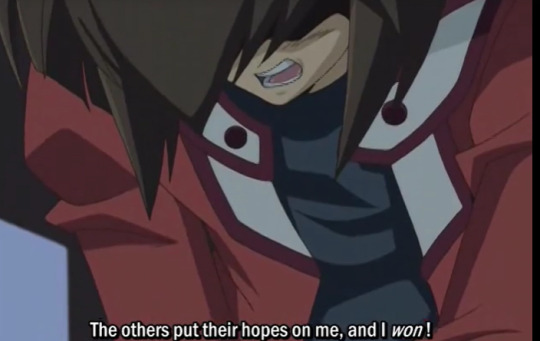
But, even then I won. The others hope their hopes on me, and I won! But still...!! They're all gone. There really was something missing within me. But what is it? What was missing?
Sho
In season one: Judai basically becomes the replacement for Sho's brother, who he has a poor relationship with and Sho has to face his inferiority complex towards his brother head on.
vs.
In season three: Shoe becomes the trigger for Judai's growth when he rejects Judai entirely and stops calling him "aniki" being the last one to abandon him in the dark world when just about everything goes wrong.
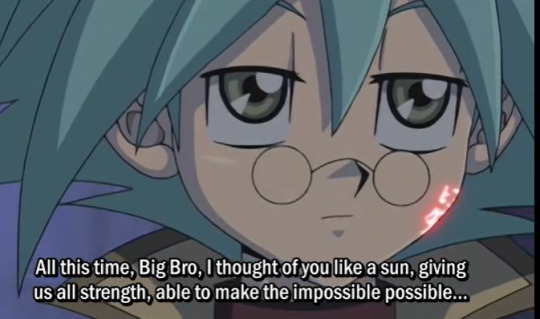
But, I guess I thought wrong. Big bro you've just been dueling to satisfiy yourself. You're not my big bro (aniki). You're not my big bro (aniki).
Fubuki
Judai even becomes lost and faces his inner darkness like Fubuki does, the first person to appear before Judai and challenge him to a Yami no Game. Fubuki who was possessed by a dark version of himself who valued power above everything else and then got lost in that darkness.
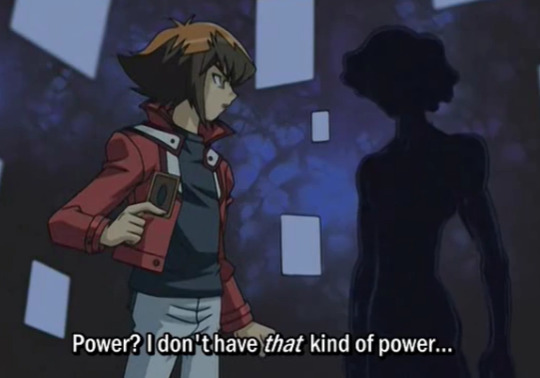
Judai has no arc in season one, and instead helps other characters along in their arcs. However, Judai's inability to change himself or confront his own inner darkness bites him when two seasons later.
Judai's arc then reflects aspects of all of their arcs. Sho's afraid that his brother doesn't love or respect him because he's an inferior duelist to Ryo. Judai loses Sho's love and respect. Asuka has to go on a journey into a darkness to find her loved one and fears Fubuki may never return. Judai repeats that same journey for Johan. Manjoume's cracks under the pressure his brothers put onto him to always win because his family's love is very conditional. Judai finally cracks when he realizes a lot of his friendship was built on the very conditional fact that he had to always win duels for them and fight for other people's hopes and dreams and not his own. In season one Judai cleanses Fubuki's inner darkness, in season 3 Judai sinks into his own inner darkness that's been there and ignored all along, and so on.
The nigredo phase is about cleansing your own impurities, and Judai is presented to us like a pure shonen hero who doesn't need to be cleansed so he spends his entire time cleansing other people - only for it to turn out his heart turned out to be darker and more selfish than anyone expected.
#ygo gx#yu gi oh gx#yu gi oh#judai yuki#alchemy#this took all day#and i still have like another one to write#ygx meta#ygo meta
45 notes
·
View notes
Text

LA MYSTÉRIEUSE COUTUME DES YEUX DE GARDE : un héritage culturel ancien de la ville de Hôi An, sur ses maisons traditionnelles.
Les yeux de garde sont une paire d'ornements fixés symétriquement au-dessus de la porte d'entrée d'une
maison.
Selon les statistiques du Centre de gestion et de conservation du patrimoine culturel de Hôi An, l'ancienne ville en compte plus de 200 modèles différents.
La forme des yeux varie, incluant des formes rondes, octogonales, hexagonales, carrées, ou encore des demi-sphères plates. Bien que leur forme diffère, chaque paire se compose toujours de deux parties principales : le noyau et le bord. Le centre est souvent décoré de symboles yin-yang, noirs et blancs, tandis que le bord entourant le centre est délicatement sculpté en forme de chrysanthème à 6 ou 8 pétales, ou en forme de feuille de Bodhi, entre autres.
Quelles que soient les explications, dans l’esprit des habitants de Hôi An, les yeux de garde sont toujours considérés comme des yeux divins qui protègent la maison. Ils sont censés repousser les mauvais esprits et maintenir un équilibre entre le yin et le yang.
Selon de nombreux chercheurs, ces yeux de garde pourraient être apparus lorsque les commerçants chinois vinrent faire des affaires dans le port de Hôi An aux XVIIe et XVIIIe siècles.
Le chercheur culturel Phùng Tân Dông, un expert de Hôi An, estime que la coutume de décorer et vénérer les yeux de garde repose sur des croyances animistes (selon laquelle toutes les choses ont une âme). Cette pratique consiste à honorer le dieu de la porte, qui protège la maison ou le temple.
En plus de cette explication, certains pensent que, comme Hôi An était autrefois un port commerçant animé avec de nombreux bateaux circulant, les habitants auraient imité la coutume des communautés littorales de dessiner des yeux de garde sur les côtés de la proue de leurs bateaux pour que les dieux les protègent des tempêtes. Ces yeux de garde auraient ensuite été transférés pour décorer les maisons avec la même symbolique.
4 notes
·
View notes
Text

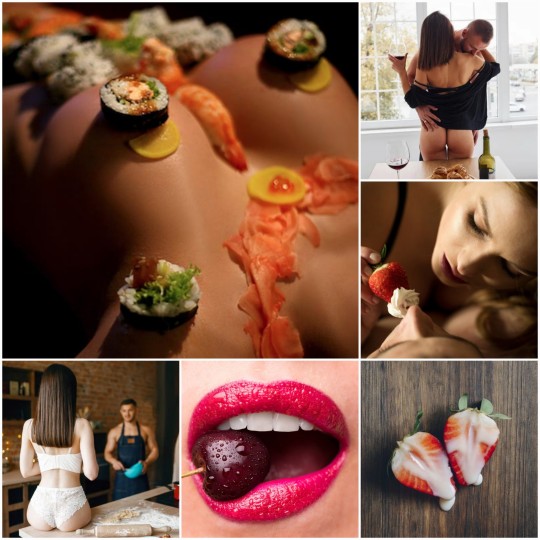
C est entendu, les bons amants sont bons cuisiniers, vice et versa...
Ils savent mélanger les arômes et les saveurs, transformer un plat ordinaire en un met délicat et raffiné à consommer sans modération ni gestion d économat...
Ceux qui connaissent l art des voluptés, de l intrication harmonieuse du yin et du yang et des ses variantes, savent mêler les 5 sens, les 5 plaisirs qui conduisent au 6eme plus extatique...
Une vraie gastronomie pour ces gourmands de la vie charnelle et unique...
14 notes
·
View notes
Photo


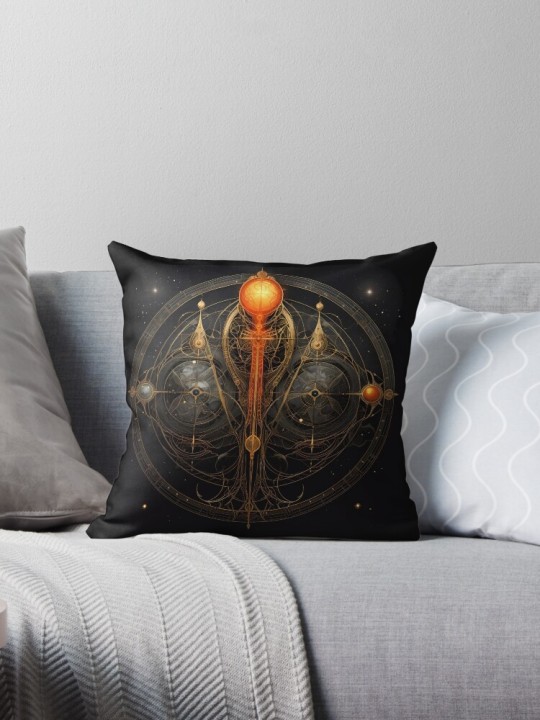







(via Coussin avec l'œuvre « "Duality Symbolized" » de l'artiste Art-Vortex-fr)
#findyourthing#redbubble#Duality Dualité Opposés Yin et Yang Équilibre Forces Contraires Harmonie Deux Mondes Deux Faces Dualisme Symboles Contradiction Double Visio
0 notes
Text

Ce n’est pas grand-chose: juste une cuve de fonte, ou de tout autre métal réfractaire, couverte d’une grille et montée sur quatre pieds (du moins dans son expression la plus simple). Il en existe des versions plus sophistiquées, mais le principe demeure le même pour ce compagnon des vacances et de la convivialité estivale. Les braises contenues dans la cuve cuiront au choix saucisses, sardines, pièces de viande ou crustacés. Vous l’avez tous reconnu, il s’agit de notre vieil ami le barbecue. C’est tout un art, le barbecue. Son allumage nécessite à lui seul un savoir-faire subtil: il faut savoir disposer le charbon de bois et l’allume-barbecue (naturel ou fourni par le supermarché local) afin d’obtenir un lit de braises homogène. Ensuite, il faudra mettre le gril à la hauteur adéquate afin d’obtenir la bonne chaleur et d’éviter le contact éventuel des flammes. Le reste ne sera plus qu’une affaire de gout. Le barbecue est une affaire d’homme. On voit rarement les femmes attiser la braise ou retourner la viande. Elles apporteront les victuailles, prépareront au besoin la marinade, viendront tenir compagnie à l’officiant, mais le feu semble rester en dehors de leur domaine. Faudrait-il y voir une application du principe chinois "Yang" (le feu, l’homme, le chaud, le soleil) opposé au "Yin" (l’eau, la femme, le froid, la lune)? La question mérite d’autant plus d’être posée que le barbecue, pour l’essentiel, sert à griller de la viande, autre élément clairement Yang. Cette masculinité peut être mise en relation avec une autre caractéristique: le barbecue, comme le méchoui, est fondamentalement une cuisine du dehors. Là encore, on retrouve l’opposition entre Yang et Yin, entre extérieur et intérieur. Il ne s’agit plus du foyer autour duquel se structure la maison. Le feu n’est plus caché, il se montre, il invite. Car le barbecue, on l’a vu, est aussi convivial. Il casse la routine du repas habituel. Participer à un barbecue, c’est participer à une fête. Il faut être relativement nombreux pour que le barbecue en vaille la peine. On ne fait pas un barbecue pour deux personnes. Cela vient d’ailleurs de loin, d’aussi loin que le mot, attesté en anglais dès le XVII siècle, et qui, à l’origine, désigne, chez certains peuples caraïbes, une claie de bois pour griller ou fumer la viande. Plus tard, il accompagnera gauchos argentins, vaqueros mexicains et leur équivalent américain. Le cowboy solitaire et loin de son foyer peut se contenter d’un modeste feu de camp où il cuira sa saucisse et ses haricots dans une poêle, mais ses collègues réunis pour convoyer un troupeau sauront organiser leur barbecue rudimentaire. Quelque part, en dégustant cette viande que nous avons vue griller, nous nous prenons nous aussi pour des hommes (ou des femmes) de la pampa ou des grands espaces. Il y a d’ailleurs quelque chose de particulier dans cette convivialité. Le barbecue n’est pas seulement collectif, il est véritablement tribal. Il ne s’agit plus seulement de la famille élargie ou d’un groupe d’amis. Réunis autour d’un mode de cuisson sinon archaïque, du moins archaïsant (le contact direct avec le feu de l’aliment cru), les convives, le temps du banquet retrouvent les fonctions primitives de la tribu, à commencer par les responsables du feu. Le barbecue fait penser au festin rituel qui clôt chaque aventure d’Astérix. Ses braises réveillent en nous une étrange nostalgie, celle des anciennes solidarités que le monde moderne a fait voler en éclats. C’est sans doute l’une des raisons, ou peut-être la raison pour laquelle le barbecue est universel. Sous des noms différents, on le retrouve aussi bien en Russie qu’en Afrique du Sud. Au Texas, il appartient à l’identité locale. Partout, du reste, on le définit plus comme un véritable art de vivre que comme une simple spécialité culinaire. Mais cette convivialité provoque aussi l’hostilité de quelques hygiénistes sourcilleux qui commencent à trouver plein de défauts et de dangers à notre barbecue.
De leur coté, les industriels s’acharnent à le moderniser en substituant au charbon de bois l’électricité ou le gaz, plus sanitairement corrects… et moins salissants. Et si le vrai barbecue était finalement un symbole de résistance ?
Jean-Michel Diard dans Minute.
2 notes
·
View notes
Note
What do you think of Chaos Magic and Phoenix being Yin & Yang to each other?
Well, first of allI think it's a gross misappropriation of the yin and yang concept. I know it's been coming up a lot with the powerscalers lately, and I think the way people are talking about it and spamming that taijitu image from AvX is kind of embarrassing. In general, I have a knee-jerk reaction against anything that could add fuel to people's obsession with arbitrary power rankings, so I don't love to linger on it.
Given that context, I've always been a little skeptical of the whole thing. At the time, the dichotomy that AvX drew between these two powers didn't make a whole lot of sense-- there was no precedent, yet, for chaos magic to be treated as "cosmic," and I've always thought it was strange to describe the Phoenix as a being of "order." These are two separate powers that are rooted in different facets of the Marvel cosmology, without a whole lot of overlap, so pairing them off this way just felt forced. I mostly enjoyed Wanda's role in the story, and I'm not opposed to the idea that chaos magic is one of the Phoenix's only weaknesses-- and vice-versa-- but the way it was executed just didn't land for me.
So, if any writer wants to revisit this dichotomy in the future, I hope that they massage to make a little more sense. It's not impossible! Our understanding of chaos magic has expanded a lot recently, so it does function better, now, as a cosmic or primordial element, but I still don't buy the Phoenix Force as "order." The current Phoenix series seeks to establish the Phoenix as a representation of "creation" within the same pantheon as Eternity and Infinity-- but there's already a Lord Chaos and Master Order within that pantheon, so positioning the Phoenix as "order" feels redundant.
Similarly, I think it's important for the chaos magic that Wanda represents to remain distinct from Lord Chaos, et al. In several mythologies, "chaos" is used to describe the primordial matter, or lack thereof, from which creation springs. If you want to draw a connection between chaos magic and the Phoenix, I think that's the way to do it. That doesn't mean one predates, or is greater than, the other-- I'm imagining it as a balanced cycle-- but it would create a more well-reasoned relational dynamic than the yin & yang imagery from AvX.
I could go on-- the role that the Waiting Room played in the Phoenix's revival, Billy & Tommy's apparent connection to the M'Kraan crystal-- but none of this is actually very interesting to me. Like I said, the Phoenix and chaos magic just exist in very different lanes, and I think that even as it expands beyond Chthon, chaos magic is still much more interesting in the realm of magic and witchcraft. I don't really need it to have anything to do with the Phoenix.
7 notes
·
View notes
